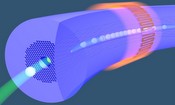An overview of the group's research into optofluidics with hollow-core photonic crystal fibres.
Optofluidic hollow-core photonic crystal fibre (HC-PCF) allows light to be guided at the centre of a microfluidic channel, maximizing its interaction with liquids and particles. This system offers unique opportunities to study photochemical reactions and in advanced optical trapping experiments.
|
|
|
|
|
|
|
|
|
|
|
|
|
collaborations This research was initiated in the group of Philip Russell at the Max Planck institute for the Science of Light in Erlangen, Germany. Our work over the past years builds on several successful collaborations including: - Peter Sadler, University of Warwick (photomedicine) With state-of-the-art labs in the new Maxwell Centre for the Physical Sciences, the Optofluidics group in NanoPhotonics establishes strong links with expertise in catalytic chemistry, microfluidics, particle technology, and spectroscopy, both within NanoPhotonics and across the School of Physical Sciences. |
References
[1] "Photonic crystal fibres for chemical sensing and photochemistry", A. M. Cubillas, S. Unterkofler, T. G. Euser, B. J. M. Etzold, A. C. Jones, P. J. Sadler, P. Wasserscheid, and P. St.J. Russell. Chem. Soc. Rev. 42, 8629 (2013). Highlighted on front cover.
[2] "Chemical and (Photo)-Catalytical Transformations in Photonic Crystal Fibers", M. Schmidt, A. M. Cubillas, N. Taccardi, T. G. Euser, T. Cremer, F. Maier, H. P. Steinrueck, P. St.J. Russell, P. Wasserscheid, and B. J. M. Etzold. Chem. Cat. Chem. 5, 641 (2013). Highlighted on front cover.
[3] "Reconfigurable optothermal microparticle trap in air-filled hollow-core photonic crystal fiber", O. A. Schmidt, M. K. Garbos, T. G. Euser, and P. St. J. Russell, Phys. Rev. Lett. 109, 024502 (2012).
[4] T. G. Euser, G. Whyte, M. Scharrer, J. S. Y. Chen, A. Abdolvand, J. Nold, C. F. Kaminski, and P. St.J. Russell, Dynamic control of higher-order modes in hollow-core photonic crystal fibers, Opt. Express 16, pp. 17972-17981 (2008).
[5] O. A. Schmidt, T. G. Euser, and P. St.J. Russell, Mode-based microparticle conveyor belt in air-filled hollow-core photonic crystal fiber, Opt. Express 21, pp. 29383-29391 (2013).
[6] "Flying particle sensors in hollow-core photonic crystal fibre", D. Bykov. O. A. Schmidt, Tijmen G. Euser, and Philip St.J. Russell. Nature Photonics 9, 461 (2015).
Further references can be found on:
http://www.researcherid.com/rid/A-2876-2014


 optofluidic microreactors
optofluidic microreactors optothermal trapping in air-filled HC-PCF
optothermal trapping in air-filled HC-PCF optical conveyor belt
optical conveyor belt flying particle sensor
flying particle sensor